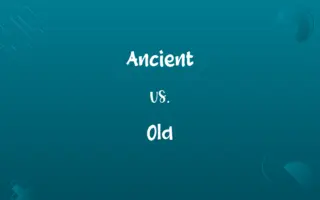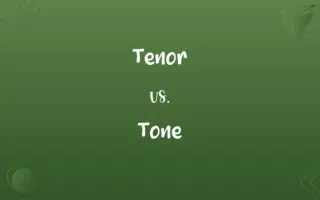Joule vs. Calorie: Know the Difference

By Shumaila Saeed || Updated on December 25, 2023
Joule is a unit of energy in the International System of Units (SI), while a Calorie is a unit of energy used in nutrition to quantify the energy content in food.

Key Differences
Joule is a unit of work or energy in the International System of Units and is used widely in physics and engineering. Calorie, on the other hand, is specifically used to measure the energy content in foods and is essential in dietary contexts.
Shumaila Saeed
Nov 23, 2023
One Joule is defined as the energy transferred when one newton of force is applied over one meter. In contrast, one Calorie (often capitalized to distinguish it from the smaller calorie) is the amount of energy needed to raise the temperature of one kilogram of water by one degree Celsius.
Shumaila Saeed
Nov 23, 2023
In scientific and technical fields, Joule is the standard unit of energy measurement. Calorie, while still used in food energy, is less common in scientific research and is often converted to joules for consistency with other energy measurements.
Shumaila Saeed
Nov 23, 2023
The Joule is part of the metric system and is universally recognized in scientific communities. Calorie has two variants: the small calorie (cal) and the large Calorie (kcal), with the latter being equivalent to 1,000 small calories and commonly used in food labeling.
Shumaila Saeed
Nov 23, 2023
Joule values are typically used to describe energy in physical and mechanical contexts, such as electricity usage or mechanical work. Calorie counts are most relevant in nutrition and health, where they indicate the energy potential of food.
Shumaila Saeed
Nov 23, 2023
ADVERTISEMENT
Comparison Chart
ADVERTISEMENT
Joule and Calorie Definitions
Joule
The energy transferred when applying one newton of force over one meter.
Pushing a box across the floor used 150 Joules of energy.
Shumaila Saeed
Nov 20, 2023
Calorie
The energy needed to raise the temperature of 1 kg of water by 1°C.
Boiling a liter of water consumes about 80 Calories.
Shumaila Saeed
Nov 20, 2023
Joule
A unit of energy in the SI system.
The lightbulb consumes 50 Joules of energy per second.
Shumaila Saeed
Nov 20, 2023
Calorie
Large Calorie (kcal) equivalent to 1,000 small calories (cal).
This meal has 500 Calories (or 500 kcal).
Shumaila Saeed
Nov 20, 2023
Joule
A measure of work done or heat produced.
The heater generates 500 Joules of heat every minute.
Shumaila Saeed
Nov 20, 2023
ADVERTISEMENT
Calorie
Indicates the potential energy in food and beverages.
The nutrition label shows 250 Calories per serving.
Shumaila Saeed
Nov 20, 2023
Joule
Used in electrical contexts to quantify energy usage.
This battery stores 2000 Joules of electrical energy.
Shumaila Saeed
Nov 20, 2023
Calorie
A unit of energy for quantifying food energy.
An apple contains about 95 Calories.
Shumaila Saeed
Nov 20, 2023
Joule
Often used to express energy in scientific experiments.
The chemical reaction released 100 Joules of energy.
Shumaila Saeed
Nov 20, 2023
Calorie
Commonly used in dietary and nutritional contexts.
She tracks her daily intake, aiming for 2000 Calories.
Shumaila Saeed
Nov 20, 2023
Joule
The International System unit of electrical, mechanical, and thermal energy, equal to the work done when a force of one newton acts through a distance of one meter, and also equal to the work done when a current of one ampere is passed through a resistance of one ohm for one second.
Shumaila Saeed
Oct 19, 2023
Calorie
Abbr. cal Any of several approximately equal units of heat, each measured as the quantity of heat required to raise the temperature of 1 gram of water by 1°C at 1 atmosphere pressure. Also called gram calorie, small calorie.
Shumaila Saeed
Oct 19, 2023
Joule
In the International System of Units, the derived unit of energy, work and heat; the work required to exert a force of one newton for a distance of one metre. Equivalent to one watt of power for a duration of one second. Symbol: J
Shumaila Saeed
Oct 19, 2023
Calorie
Abbr. cal The unit of heat equal to 1/100 the quantity of heat required to raise the temperature of 1 gram of water from 0 to 100°C at 1 atmosphere pressure. Also called mean calorie.
Shumaila Saeed
Oct 19, 2023
Joule
A unit of work which is equal to 107 ergs (the unit of work in the C. G. S. system of units), and is equivalent to one watt-second, the energy expended in one second by an electric current of one ampere in a resistance of one ohm; also called the absolute joule. It is abbreviated J or j. The international joule is slightly larger, being 1.000167 times the absolute joule. The absolute joule is approximately equal to 0.737562 foot pounds, 0.239006 gram-calories (small calories), and 3.72506 x 10-7 horsepower-hours, and 0.000948451 B.t.u.
Shumaila Saeed
Oct 19, 2023
Calorie
Abbr. Cal The unit of heat equal to the amount of heat required to raise the temperature of 1 kilogram of water by 1°C at 1 atmosphere pressure. Also called kilocalorie, kilogram calorie, large calorie.
Shumaila Saeed
Oct 19, 2023
Joule
A unit of electrical energy equal to the work done when a current of one ampere passes through a resistance of one ohm for one second
Shumaila Saeed
Oct 19, 2023
Calorie
A unit of energy-producing potential equal to this amount of heat that is contained in food and released upon oxidation by the body. Also called nutritionist's calorie.
Shumaila Saeed
Oct 19, 2023
Joule
English physicist who established the mechanical theory of heat and discovered the first law of thermodynamics (1818-1889)
Shumaila Saeed
Oct 19, 2023
Calorie
(nutrition) Kilogram calorie or large calorie. A unit of energy 1000 times larger than the gram calorie. It is equivalent to the gram kilocalorie, approximately 4.2 kilojoules.
Shumaila Saeed
Oct 19, 2023
Calorie
The gram calorie or small calorie, a non-SI unit of energy, equivalent to approximately 4.2 joules. This unit was widely used in chemistry and physics, being the amount of energy needed to raise the temperature of 1 gram of water by 1 °C.
Shumaila Saeed
Oct 19, 2023
Calorie
The unit of heat according to the French standard; the amount of heat required to raise the temperature of one kilogram (sometimes, one gram) of water one degree centigrade, or from 0° to 1°. Compare the English standard unit, Foot pound.
Shumaila Saeed
Oct 19, 2023
Calorie
Unit of heat defined as the quantity of heat required to raise the temperature of 1 gram of water by 1 degree centigrade at atmospheric pressure
Shumaila Saeed
Oct 19, 2023
Calorie
A unit of heat equal to the amount of heat required to raise the temperature of one kilogram of water by one degree at one atmosphere pressure; used by nutritionists to characterize the energy-producing potential in food
Shumaila Saeed
Oct 19, 2023
Repeatedly Asked Queries
What does a Calorie measure in food?
It measures the energy content or potential energy in food.
Shumaila Saeed
Nov 23, 2023
Why are Calories important in diet?
Calories represent the energy a person gains from consuming food, crucial for maintaining bodily functions and activities.
Shumaila Saeed
Nov 23, 2023
How is Calorie labeled on food packages?
It's usually labeled as Calories or kcal, indicating the energy content per serving.
Shumaila Saeed
Nov 23, 2023
Can Joule and Calorie be interconverted?
Yes, 1 Joule is approximately equal to 0.239 small calories, and 1 Calorie (kcal) equals 4.184 Joules.
Shumaila Saeed
Nov 23, 2023
What is a Joule primarily used for?
Joule is used as a measure of energy in physics, engineering, and general science.
Shumaila Saeed
Nov 23, 2023
Can I calculate my energy expenditure in Joules?
Yes, physical activities can be quantified in terms of energy expenditure in Joules.
Shumaila Saeed
Nov 23, 2023
Is the Joule used internationally?
Yes, Joule is the internationally recognized unit of energy in the metric system.
Shumaila Saeed
Nov 23, 2023
Is Joule used in everyday life?
It's used in scientific and technical contexts but less so in daily life.
Shumaila Saeed
Nov 23, 2023
What’s the difference between a small calorie and a large Calorie?
A small calorie (cal) is the energy needed to raise 1 gram of water by 1°C, while a large Calorie (kcal) is 1,000 times that amount, used for food energy.
Shumaila Saeed
Nov 23, 2023
How do Calorie needs vary among individuals?
Caloric needs vary based on factors like age, gender, activity level, and metabolic rate.
Shumaila Saeed
Nov 23, 2023
Why don’t all countries use Calories for food energy?
Some countries use joules or kilojoules (kJ) on food labels for consistency with other energy measurements.
Shumaila Saeed
Nov 23, 2023
Are Joules used in calculating electrical energy consumption?
Yes, electrical energy is often measured in Joules or kilowatt-hours (which are a larger unit).
Shumaila Saeed
Nov 23, 2023
Why is understanding Calories important for weight management?
Balancing Caloric intake with energy expenditure is key to maintaining or altering weight.
Shumaila Saeed
Nov 23, 2023
Can the Calorie be used in physics?
It can be, but Joule is more common and standardized in physics.
Shumaila Saeed
Nov 23, 2023
What is a kilojoule (kJ)?
A kilojoule is 1,000 Joules and is used as a larger unit of energy.
Shumaila Saeed
Nov 23, 2023
Do nutritionists use Joules?
They predominantly use Calories but may convert to Joules for scientific purposes.
Shumaila Saeed
Nov 23, 2023
Are all food Calories the same in terms of energy?
Yes, in terms of energy content, but the nutritional value can vary greatly.
Shumaila Saeed
Nov 23, 2023
How accurate are Calorie counts on food labels?
They are generally accurate but can vary based on factors like preparation methods.
Shumaila Saeed
Nov 23, 2023
Is the Joule relevant in mechanical work?
Yes, it's used to measure the energy expended in mechanical work.
Shumaila Saeed
Nov 23, 2023
Is it important to know both Joules and Calories?
Understanding both is useful, especially in fields involving nutrition, health, and science.
Shumaila Saeed
Nov 23, 2023
Share this page
Link for your blog / website
HTML
Link to share via messenger
About Author
Written by
Shumaila SaeedShumaila Saeed, an expert content creator with 6 years of experience, specializes in distilling complex topics into easily digestible comparisons, shining a light on the nuances that both inform and educate readers with clarity and accuracy.






































































